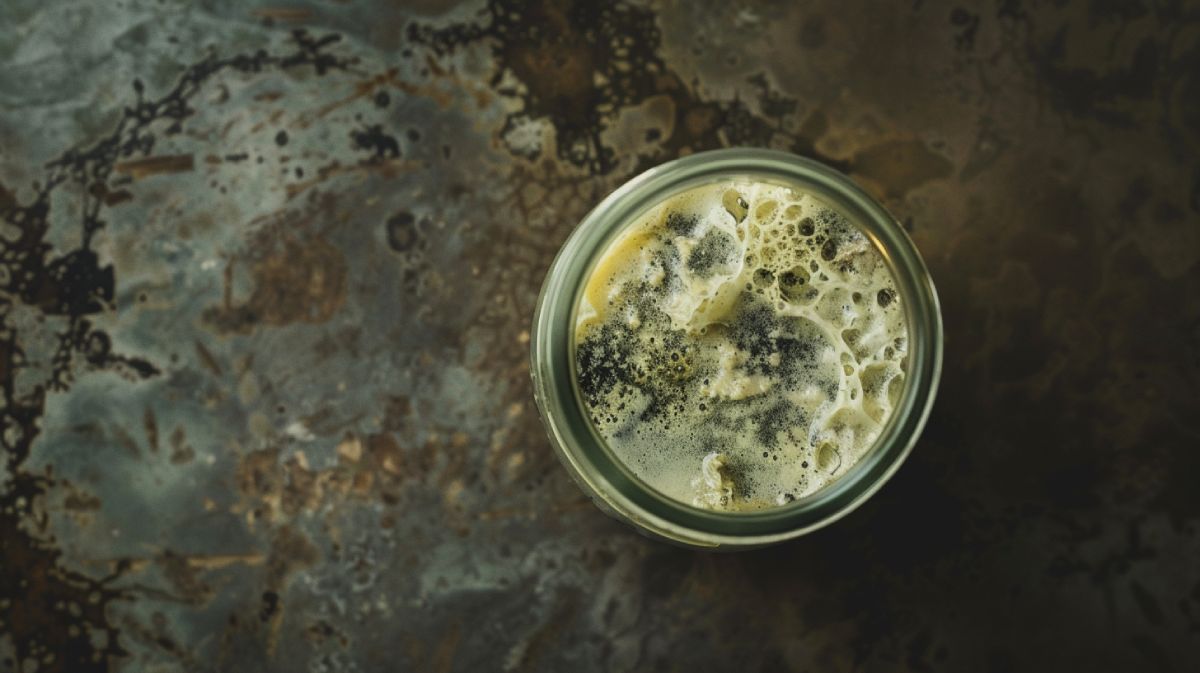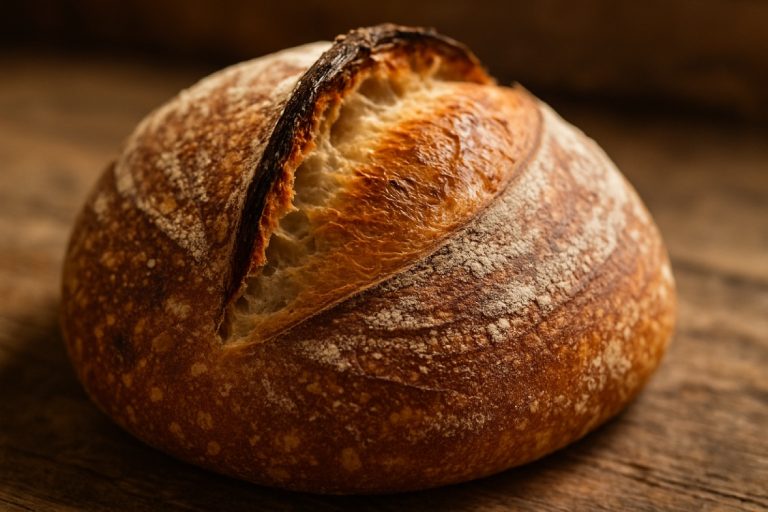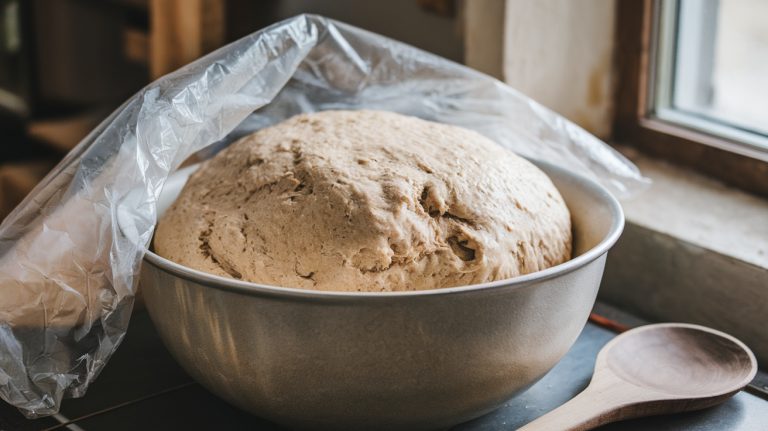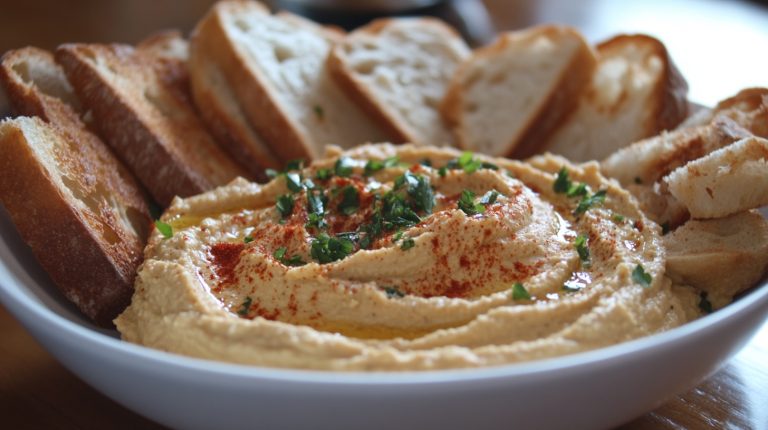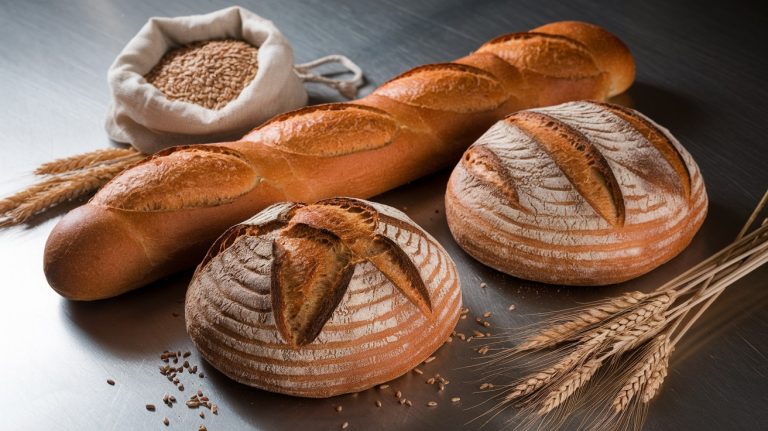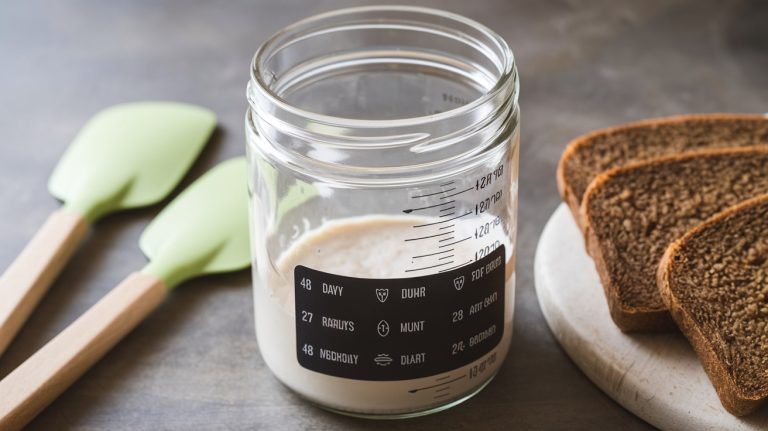Mold in Sourdough Starter Jar: Identification and Solutions
Discovering mold in your sourdough starter jar is a concern. Mold typically appears as fuzzy patches and emits a musty smell, unlike harmless kahm yeast, which looks like a thin, white layer. Mold can result from contaminated ingredients, dirty utensils, poor water quality, or improper storage. To fix this, remove the mold, transfer the starter to a clean jar, and refresh it with unbleached flour and water.
Regular feedings, sterilizing utensils, and proper storage can prevent future mold growth. The following information provides more on identifying and preventing this issue.
Key Takeaways
- Mold appears as fuzzy patches in green, black, or gray and often has a musty smell.
- Discard the starter if mold is present to avoid health risks.
- Use sterilized jars and utensils to prevent mold contamination in the starter.
- Maintain a consistent feeding schedule and use unbleached flour and clean water.
- Transfer uncontaminated portions of the starter to a clean jar if mold appears.
Causes of Mold
Several factors can cause mold in sourdough starter jars, including contaminated ingredients, dirty utensils, poor water quality, improper storage conditions, and environmental mold spores.
One critical cause is the use of contaminated ingredients. Flour, especially if improperly stored, can harbor mold spores. Avoid using bleached flour, as it often lacks the necessary nutrients for a healthy starter and might contain unwanted contaminants.
Your tools also play a significant role. Using unclean utensils or jars introduces mold into your sourdough environment. Ensure all equipment is thoroughly cleaned and sanitized before use.
Water quality is another vital factor. Chlorinated city water can disrupt the balance of your starter, leading to mold growth. Opt for filtered or bottled water to maintain an ideal environment.
Improper storage conditions, such as fluctuating temperatures and high humidity, create a breeding ground for mold. Keep your sourdough starter in a consistent, cool environment.
Finally, mold spores from the environment can easily settle in your jar. Adopting stringent sanitation practices, like covering your jar with a breathable but protective cloth, helps mitigate this risk.
Identifying Mold Vs. Kahm Yeast
Understanding the difference between mold and kahm yeast in your sourdough starter jar is essential to maintaining a healthy and safe fermentation process. Mold can be identified by its fuzzy appearance and patches of green, black, or gray. It often emits a musty smell and can penetrate deeper into the starter, posing significant health risks.
In contrast, kahm yeast forms a thin, white or creamy layer on the surface and is harmless.
When inspecting your starter, look for these distinguishing features:
- Mold: Fuzzy patches, often green, black, or gray.
- Musty smell: Indicates mold presence.
- Kahm yeast: Thin, white or creamy layer.
- Velvety appearance: Suggests mold rather than kahm yeast.
Mold’s fuzzy and velvety appearance is a key indicator that it’s not just harmless kahm yeast. If you notice mold, it’s safer to discard the starter to avoid health risks. Kahm yeast, however, doesn’t penetrate the starter and can be skimmed off without concern. By understanding these differences, you ensure your sourdough starter remains safe and effective for baking.
Always err on the side of caution if you’re uncertain about what you’re seeing.
Preventing Mold Growth
Maintaining a consistent feeding timetable is vital to preventing mold growth in your sourdough starter jar. Regular feedings guarantee that your starter remains active and acidic, which naturally hinders mold formation. Aim to feed your starter at least once a day if kept at room temperature or once a week if stored in the refrigerator.
Use sterilized jars and utensils when handling your sourdough starter to minimize contamination. Cleanliness is essential; even small amounts of foreign bacteria or mold spores can contaminate your starter.
Keeping your starter at a reasonably liquid consistency also helps create a protective layer. This liquid barrier prevents air and mold spores from settling on the surface. Make sure your starter has enough liquid on top to maintain this protective layer.
Avoid reintroducing dead or over-proofed starter back into the jar, as this can increase the risk of mold growth. Always discard any unused portion that shows signs of inactivity or spoilage.
Dealing With Mold
If mold appears in your sourdough starter jar despite preventive measures, you’ll need to act swiftly to salvage the uncontaminated portions and guarantee the starter remains viable for baking. First, carefully examine the extent of the mold contamination. Visible mold often appears on the top of the jar, but the deeper layers may remain unaffected.
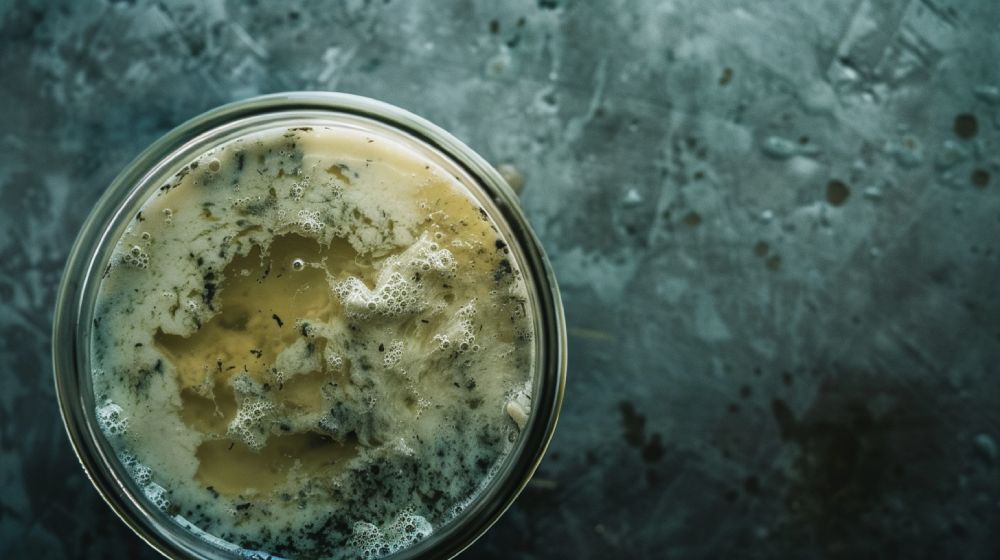
Use clean tools to scrape off the moldy parts, ensuring you don’t push mold spores further into the starter. Transfer the unaffected starter to a clean jar. By employing good hygiene practices, you can prevent mold from recurring. Be sure to use unbleached flour and clean jars to maintain the starter’s health.
Here’s a step-by-step guide to dealing with starter mold:
- Scrape off mold: Use clean tools to remove mold from the top of the jar without contaminating the rest.
- Transfer to a clean jar: Move the uncontaminated starter to a new, sterilized container.
- Monitor starter smells: Unusual odors indicate possible contamination; discard if necessary.
- Refresh starter: Feed with unbleached flour and water to rejuvenate it.
Maintaining Starter Health
Regularly feeding your sourdough starter with unbleached flour and clean water is necessary to ensure its long-term health and vigor. Consistent feeding sustains the microbial balance necessary for a healthy starter, characterized by bubbles and a pleasant aroma.
Neglecting your starter can lead to a moldy sourdough starter, adversely affecting its health and the bread quality. To maintain starter health, you need to monitor it closely. Check for any signs of mold or unusual smells. If mold appears, act promptly to remove the moldy parts and transfer the starter to a clean jar. This proper care can help revive it and restore its health.
The microbial balance in your starter is vital for both its vitality and the flavor profile of the bread it produces. Regular feeding keeps the beneficial bacteria and yeasts active, ensuring robust fermentation and the best bread rise.
Frequently Asked Questions
Can I Use My Sourdough Starter if It Has Mold?
You can’t use your sourdough starter if it has mold. Mold can produce harmful toxins, making it unsafe. Discard it immediately and start fresh to guarantee food safety and avoid potential health risks.
How Do You Know If Your Sourdough Starter Is Bad?
To determine if your sourdough starter is bad, look for unusual colors like green, black, or gray, fuzzy spots, black patches, or a foul odor. Pink or orange streaks also indicate potential issues. Discard if unsure.
What Does Mold on Sourdough Look Like?
Imagine a dark cloud on a sunny day—that’s mold in your sourdough starter. You’ll spot fuzzy spots, velvety patches, or colors like green, black, or gray. These signs symbolize contamination and necessitate discarding the starter.
How Often Should You Clean Your Sourdough Starter Jar?
It would be best to clean your sourdough starter jar every time you feed it. This practice prevents contamination, promotes beneficial microbial growth, and guarantees ideal fermentation. Regular cleaning with hot, soapy water is essential for maintaining starter health.
Mold Alert: Act Fast to Save Your Sourdough
You’ve got to be attentive with your sourdough starter, or mold will invade like an unstoppable conqueror! To avoid this culinary catastrophe, always guarantee your jar is impeccably clean, maintain the right hydration levels, and feed it regularly.
If mold does appear, don’t hesitate—dispose of the entire batch immediately. With meticulous care and attention, your starter can thrive, producing the most exquisite, flavorful bread imaginable. Remember, a healthy starter is your golden ticket to baking perfection.

